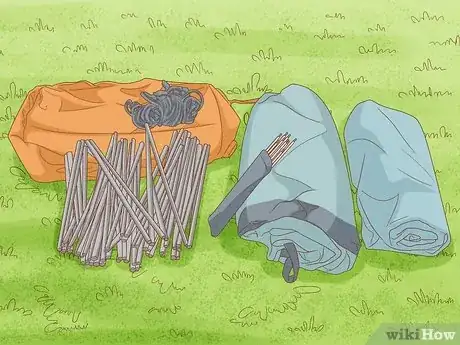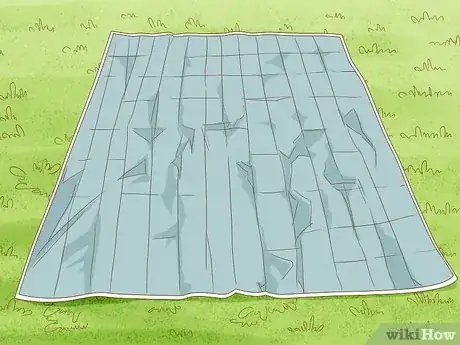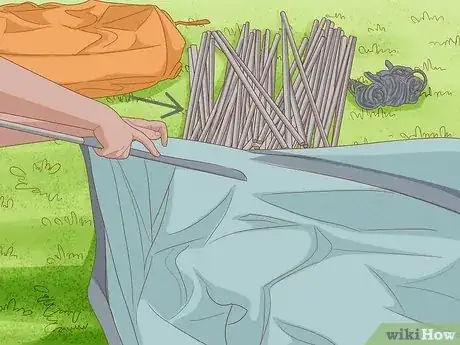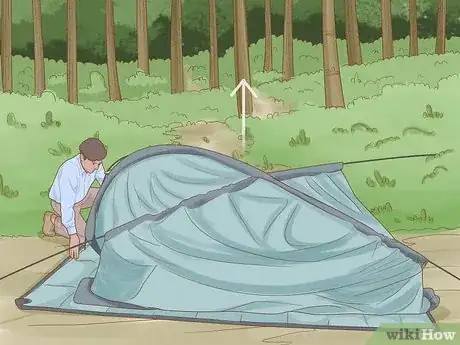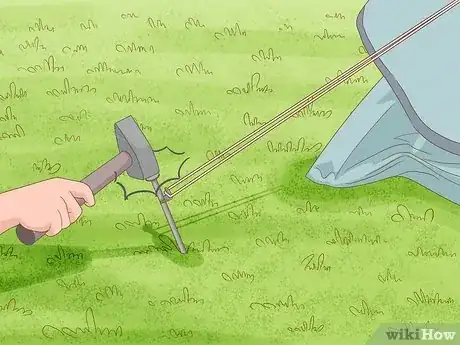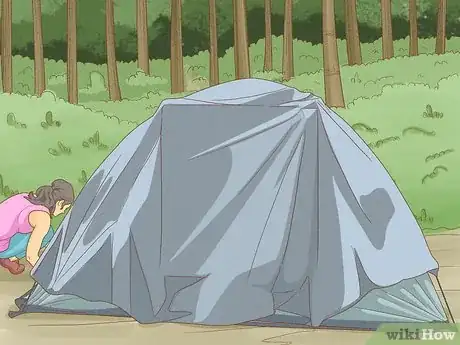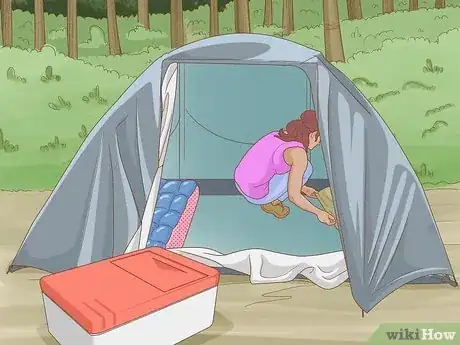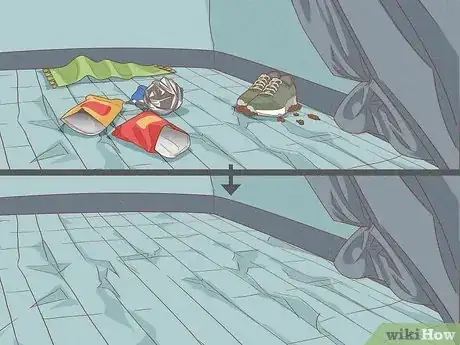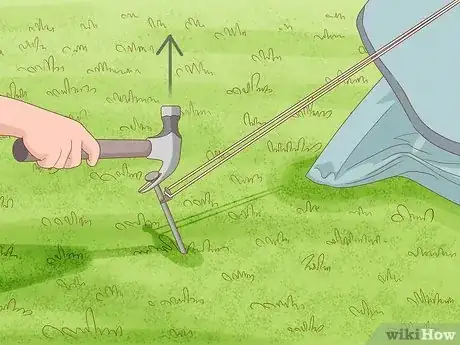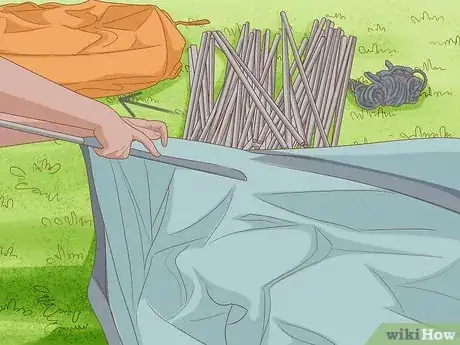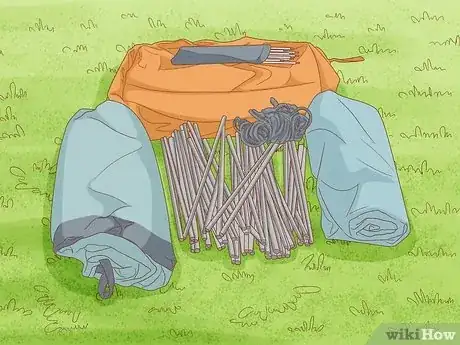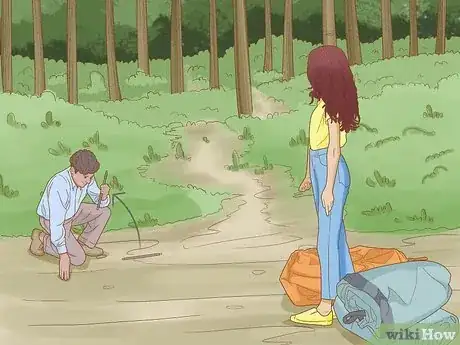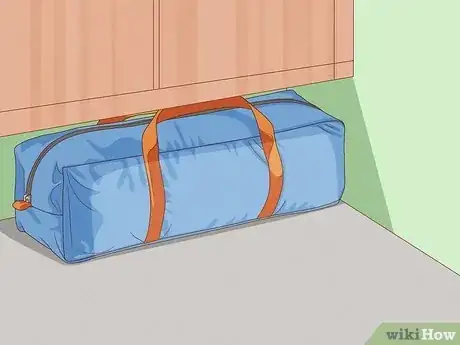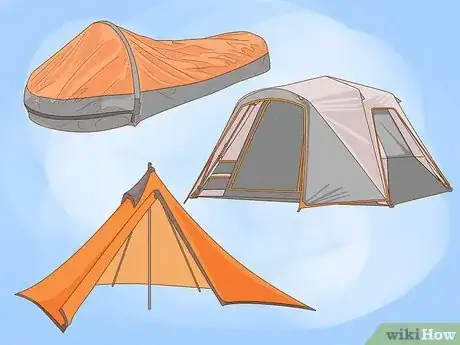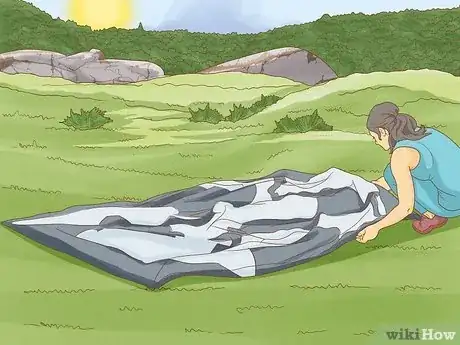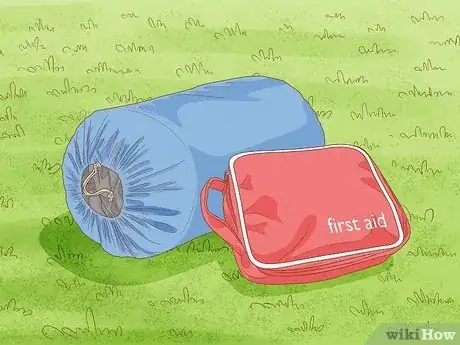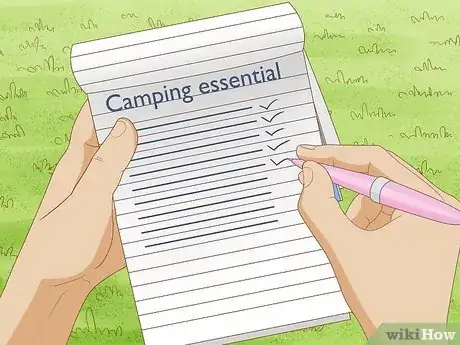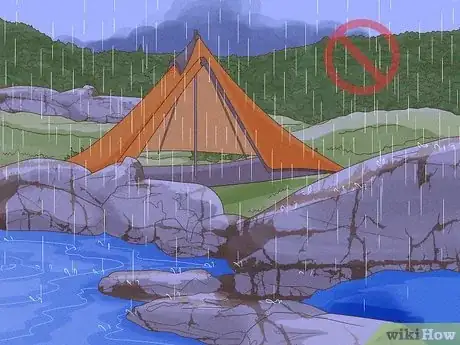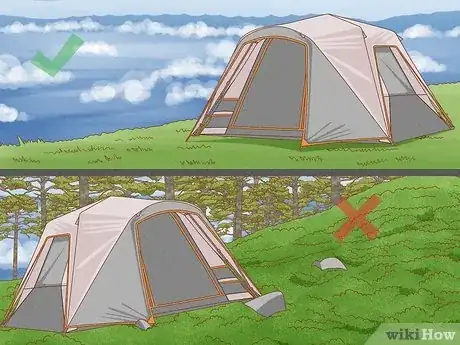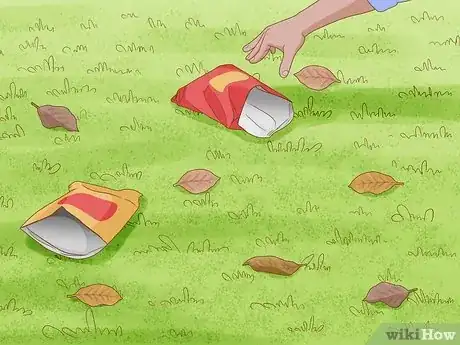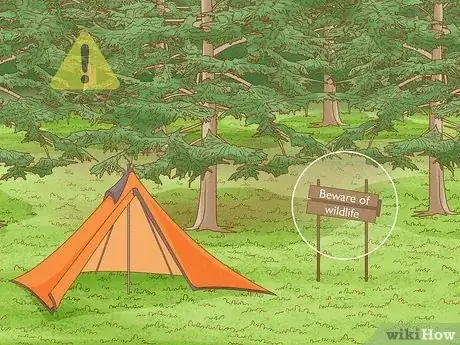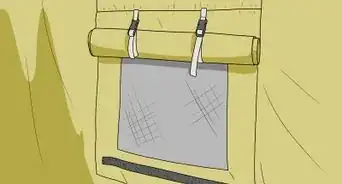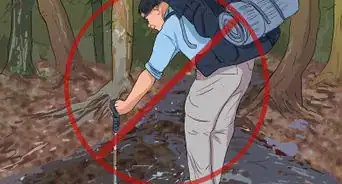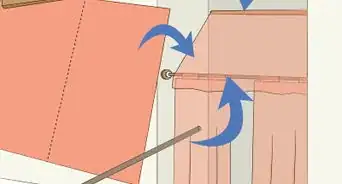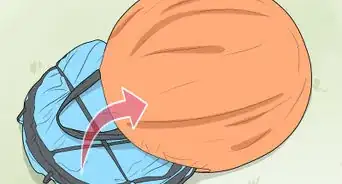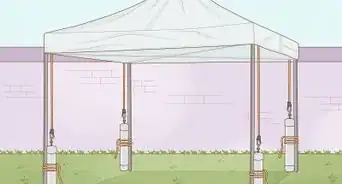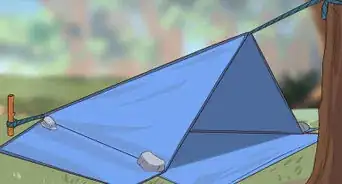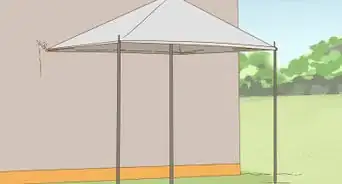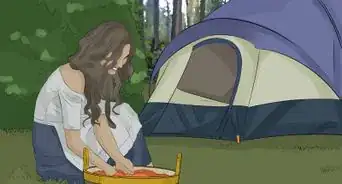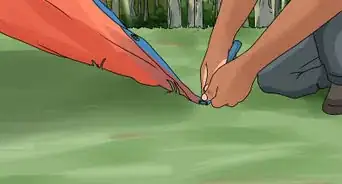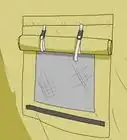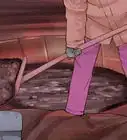This article was co-authored by Halle Payne. Halle Payne has been hiking and backpacking in Northern California for over 3 years. She was Trip Leader for Stanford University’s Outdoor Education Program, Hiking Leader for Stanford Sierra Conference Center, and has taught classes in Outdoor Education and Leave No Trace principles.
This article has been viewed 208,673 times.
Camping is a great activity in the summertime. Living out in a tent for a few days is a great opportunity to relax and get more in touch with nature. While it's a mostly fun activity, getting the tent itself together can be a real chore, especially if you're not used to the ins and outs of camping yet. Although it may seem tough at first, most tents are made with ease-of-install in mind. While assembling a tent is usually pretty straightforward, there's a lot more involved in making a successful campsite. Preparedness and scoping out the right location are essential before assembling the tent itself.
Steps
Setting Up Your Tent
-
1Unpack your tent supplies.[1] Once you've found a good area to set up camp, it's time to unpack your things. It's a good idea to pack all of the parts out at once. Assembling your tent will be fastest if you don't have to unpack each item one at a time. Keep all parts nestled in one place so you can keep account of everything. Because the list of supplies depends on the specific type of tent you're using, here are a few different types of tents you can consider:
- A-Frame tents are the most typical and common type of tent for personal use. They're the easiest to erect and usually come with extras like a rain-fly and weather tarp.
- Tunnel tents are different from typical "A-Frame" tents because they are structured by two long poles that both run the width of the tent. This creates a wider interior with more headspace. However, they're not nearly as stable when it comes to wind.
- Dome tents are generally the largest, and usually reserved for larger groups in camping. Although they're quite a bit bigger, they're generally very easy to pitch.
-
2Lay down a ground cloth.[2] No matter how much you clear the area, there may still be twigs and other debris that could puncture your tent or make the surface otherwise uncomfortable. A ground cloth should be big enough to encompass the space of at least most of your tent. The added cushion of a ground cloth will lead to a more comfortable rest.Advertisement
-
3Insert your tent poles through the frame.[3] Once you've gotten all your tent parts out, slide the support poles through the body of the tent. Lie the tent frame out. That way, you can make sure you're sliding the poles through the right slots. This is arguably the most time-consuming part of tent assemblage, but it's very straightforward.
- In the case of a "tunnel tent", make sure the poles are parallel from one another.
-
4Raise the tent. If the support poles have joints, make them rigid. The poles are going to have a pre-set frame to them for the main body of the tent. Help the tent up by lifting parts of it. The poles should hold the frame in place. If not, secure loose parts of the poles or extend them as needed.
-
5Hammer in your tent pegs.[4] Using a mallet or a nearby rock, take the spikes that come with your tent and hammer them into the ground. This will stabilize the tent and make sure it doesn't move around. If you don't have tent pegs for whatever reason, you can improve by using sturdy sticks and pushing them into the soil.
-
6Set up the rain-fly.[5] It's important to keep in mind that tents on their own are usually not waterproof. This is where the rain-fly comes in. A rain-fly is an additional piece you set overtop the tent. There should be something along the line of latches on the roof of your tent to secure the rain-fly in place. Even if you're pretty sure there will be no rain, it doesn't hurt to install it nonetheless. It will ensure all of your tent equipment stays in one place, and prepare you for unforeseen rain showers.
-
7Move your things into the tent. Once the tent is set up, you can equip the interior. Because there isn't usually much space in a tent, you should decide which things are alright to store outside, and which things should be kept inside. Sleeping bags are an obvious must in your tent. Crates and hard-cased storage can be left outside.
- If there's a risk of bears in the area you're camping, it is strongly recommended you keep food out of the tent. If a bear comes, you don't want him rummaging into your tent because he picked up the scent of granola.
Taking Down Your Tent
-
1Keep your tent clean while you camp.[6] It's a good idea to keep your tent clean while you're camping. This makes the experience of camping nicer, but it also makes the cleanup process easier. Make an effort to keep shoes off while you're in the tent. Keep the space clutter-free and throw out excess wrappers appropriately.
-
2Unpeg the tent from the ground. Taking pegs out is usually pretty easy, and should be the first thing you do before dismantling your tent. If you can't pull them up by hand, try digging out the soil around the peg to loosen it.
- The rain-fly should be unlatched as soon as possible as well.
-
3Remove the poles from the frame. Once the pegs are out, pull the bottoms of the tent poles out from the sockets in the fabric. Do this for all four corners before you move on and take out upper sockets. This will make sure the tent isn't imbalanced later on during the dismantling.
- Take down the camp slowly. Even the best tents can be fragile if you're not careful.
-
4Keep all of the tent parts in one place. While you're putting pegs and poles aside, do your best to keep them all in one place. You should be storing them all in one place usually, but it's especially important if you're out camping. You don't want to drive away without first taking account of all the parts.
-
5Scan the campsite for anything you might have missed. Once the camp is dismantled, you should do a last-minute scan to make sure there isn't anything you accidentally left or forgot about. In most cases you'll be able to account for everything, but it definitely helps for the occasions you'll have missed something. While you're scanning, you should make sure you haven't left any garbage. You should make the campsite look as good or better than when you left it.
-
6Store your tent supplies somewhere dry. Once you get back home, you should keep the tent parts in one place and somewhere dry. If the tent gathers mildew or moisture over time, this will rot out the fabric and ruin the tent for any future use.
Creating the Best Camping Experience Possible
-
1Buy a tent that accurately suits your needs. There are lots of different types and sizes of tent on the market. Some are only big enough to fit one or two people, while others are massive enough to include tables and chairs. If you're buying a tent for personal use, you should stick to smaller-sized tents. Bigger tents are harder to carry around, and usually take longer to put together and dismantle.
- Tents will usually have a recommended persons limit on the box. Although the worth of these estimates is a bit iffy (you should usually round up the number, if anything) it can give you some insight as to the approximate size.
- Don't cheap out and purchase the discount brands of tent. Although you'll save money, they wear out quickly and lack the protection of better tents. You'll be making this tent your home on more than one occasion after all, so it's worth to spend a bit more and go for at least a run-of-the-mill model
-
2Do a practice run-through of setting up the tent.[7] Generally speaking, you're going to want your camping experience to be as problem-free as possible. Any new tent is going to take a bit of time to figure out how it goes together. With these two things in mind, it's a good idea to set the tent up in your back yard or living room before you even leave for your trip. You'll be able to work out the kinks in the assembly process without having to worry about time or having somewhere to sleep.
- This is also recommended in the small possibility that the package did not come with all its parts. If there was a fault on the part of the manufacturer, you can send it back and get a replacement version.
-
3Remember to bring first-aid. Among the more obvious things like food and clothing, its essential that you bring some kind of basic first-aid kit with you whenever you camp. Bandages, over-the-counter painkillers, gauze and topical cream are some of the things you should bring with you. Although serious injury is unlikely, minor scrapes and bruises are commonplace when you're outdoors, and you'll want to get to soothe them quickly so that they don't impact your experience.
-
4Make sure you have everything before you leave. It's a preventable pain to realize you've forgotten something necessary at home. This is especially true if you get to your camping location and realize you left something essential for the tent behind. Even if you're in a rush out the door, take a few extra minutes to verify you have all your bases covered.
- It's useful to write up a quick list of the things you and your party will need for a trip.
Finding a Good Place to Camp
-
1Look out for apparent hazards. When you get to a potential camping location, you should give a quick glance around to see if you spot anything dangerous. Chances are you will be camping in a natural woodland area. If this is true, it's a good idea to read up on your location a bit beforehand to see what kind of hazards other people have reported.
- Broken trees above can be lethal if they fall on your tent in the tent. It's best to stay clear of anything that looks unstable.
- Bee hives are hard to spot in a wild area. All the same, the sight of one is a good sign you should stay away.
- The common sight of animal droppings is an indication that this is an area that gets a lot of animal traffic. Although many animals will steer clear of you, some predators (often bears) will make a target of campsites.
-
2Avoid setting up in low areas if there's a chance of rain.[8] It's not recommended that you camp on a day where there's a likelihood of rain in the first place, but just in case, it's a good idea not to set your campsite in a depression in the ground. If it rains, the rain will trickle down and risk flooding your campsite.
-
3Find a flat space.[9] Tents need a flat space to be set up properly. This is the ground you'll be sleeping on, so it's necessary you find the flattest possible piece of ground within reason. Keep the size of your tent in mind, and accommodate for a space outside the tent gate. Having a hill drop right outside the door is a recipe for injury.
-
4Clear the chosen area of debris.[10] Once you've found a relatively flat area that's free of apparent hazards, you should prep the campsite by clearing out debris that could hurt the tent or make the surface uneven. Although broken glass can be legitimately dangerous to camp on, you won't be able to sleep if there are stones on the ground where you're trying to rest.[11]
-
5Make sure the area is reasonably clear of wildlife. If you're camping out in a relatively wild area, you should be prepared for the possibility of animals. Although most animals will stay clear from humans, bears are a major danger and can be lethal. Seeing a lot of animal droppings can be a sign that you're close to an animal's hunting ground. Although you'll never be able to know for sure, you can usually look up the camping region beforehand to see if other people have reported bear sightings.
- If there is any risk, you should keep things like food out of your tent. That way, a bear won't need to rummage into your tent if he picks up the food's scent.
Expert Q&A
-
QuestionHow do you hammer a tent peg?
 Halle PayneHalle Payne has been hiking and backpacking in Northern California for over 3 years. She was Trip Leader for Stanford University’s Outdoor Education Program, Hiking Leader for Stanford Sierra Conference Center, and has taught classes in Outdoor Education and Leave No Trace principles.
Halle PayneHalle Payne has been hiking and backpacking in Northern California for over 3 years. She was Trip Leader for Stanford University’s Outdoor Education Program, Hiking Leader for Stanford Sierra Conference Center, and has taught classes in Outdoor Education and Leave No Trace principles.
Hiking & Backpacking Trip Leader I typically use a rock, but be careful not to hit your fingers in the process! If the soil is soft, sometimes it will just go right in if you press down with your foot or hand.
I typically use a rock, but be careful not to hit your fingers in the process! If the soil is soft, sometimes it will just go right in if you press down with your foot or hand. -
QuestionWhat do you put inside a tent?
 Halle PayneHalle Payne has been hiking and backpacking in Northern California for over 3 years. She was Trip Leader for Stanford University’s Outdoor Education Program, Hiking Leader for Stanford Sierra Conference Center, and has taught classes in Outdoor Education and Leave No Trace principles.
Halle PayneHalle Payne has been hiking and backpacking in Northern California for over 3 years. She was Trip Leader for Stanford University’s Outdoor Education Program, Hiking Leader for Stanford Sierra Conference Center, and has taught classes in Outdoor Education and Leave No Trace principles.
Hiking & Backpacking Trip Leader Things you don't want to get wet can go in the tent. As long as your rain-fly is set up well, and staked down on opposite sides, your gear will be protected in the case of rain. I was taught when you leave the camp site, your set-up should be storm proof.
Things you don't want to get wet can go in the tent. As long as your rain-fly is set up well, and staked down on opposite sides, your gear will be protected in the case of rain. I was taught when you leave the camp site, your set-up should be storm proof.
Warnings
- Make sure the area where you're camping is legal first.⧼thumbs_response⧽
References
- ↑ http://www.overstock.com/guides/how-to-set-up-a-tent
- ↑ http://www.lowergear.com/advice.php/content/tent_care_and_setup
- ↑ https://www.pitchup.com/how-set-up-tent/
- ↑ https://www.pitchup.com/how-set-up-tent/
- ↑ http://www.overstock.com/guides/how-to-set-up-a-tent
- ↑ http://www.lowergear.com/advice.php/content/tent_care_and_setup
- ↑ http://www.overstock.com/guides/how-to-set-up-a-tent
- ↑ http://www.lowergear.com/advice.php/content/tent_care_and_setup
- ↑ http://www.overstock.com/guides/how-to-set-up-a-tent
About This Article
To assemble a tent, first lay down the ground cloth on the area that you want your tent to be. Next, insert the tent poles through the slots in the body of the tent, also called the frame. Once the poles are inserted, connect the joints of the poles to raise the tent. Finally, hammer the tent pegs into the ground with a mallet or rock to hold the tent down. Additionally, you can set up the rain-fly, which is a waterproof piece that sits on top of the tent. To learn how to create the best camping experience possible, read on!
